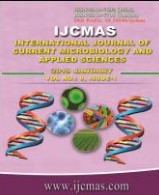


 National Academy of Agricultural Sciences (NAAS)
National Academy of Agricultural Sciences (NAAS)

|
PRINT ISSN : 2319-7692
Online ISSN : 2319-7706 Issues : 12 per year Publisher : Excellent Publishers Email : editorijcmas@gmail.com / submit@ijcmas.com Editor-in-chief: Dr.M.Prakash Index Copernicus ICV 2018: 95.39 NAAS RATING 2020: 5.38 |
The current study focuses on designing biodegradable transferosomal hydrogel using lignans and bio surfactant for transdermal applications. In the study, the lignans concentrate (LC) was extracted from flaxseeds and used to prepare vesicular transferosomes/transferosomal hydrogel by thin film hydration technique for drug delivery. The resultant formulations were characterized using light microscopy, DLS, Zeta potential, entrapment efficiency (EE %) and stability. In vitro skin permeation studies were also performed. The synthesized transferosomes were spherical in shape. The entrapment efficiency (%EE) of transferosomes with synthetic surfactant (SST) was 38.54% while the efficiency obtained by bio-surfactant transferosomes (BST) was 45.87%. Upon optimization, BST exhibited improved %EE (75.81 %). The particle sizes, zeta potential and PDI of BST were 213.4 nm, -30.6 mV, 0.316 and of SST210.5 nm, −23.62 mV, 0.349, respectively. The transferosomes follow Higuchi model whereas transferosomes hydrogel follow the First order kinetics. The transferosomes were stable over a month at 4°C and exhibited similar transdermal permeation as fresh samples. The Hydrophile-Lipophile Balance (HLB) of SPL was in the order of 13 to 15making BST a better alternative to synthetic surfactants. Thus it can be concluded that the transferosomal hydrogels infused with sophorolipid could be used as carriers of LC with promising permeation characteristics for transdermal and cosmetic applications.
 |
 |
 |
 |
 |